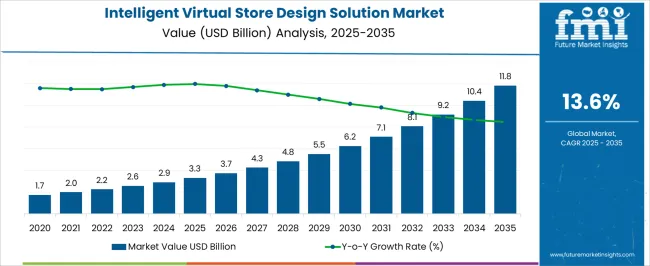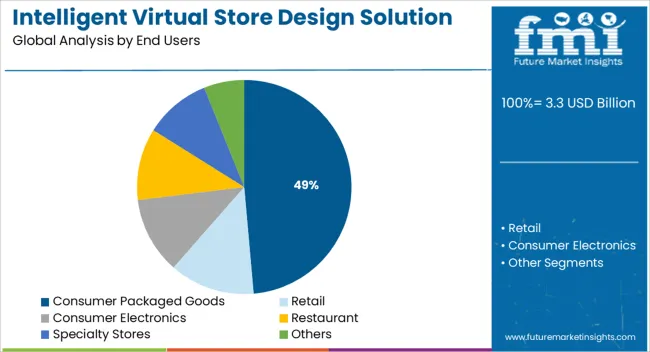The Intelligent Virtual Store Design Solution Market is estimated to be valued at USD 3.3 billion in 2025 and is projected to reach USD 11.8 billion by 2035, registering a compound annual growth rate (CAGR) of 13.6% over the forecast period.

| Metric | Value |
|---|---|
| Intelligent Virtual Store Design Solution Market Estimated Value in (2025 E) | USD 3.3 billion |
| Intelligent Virtual Store Design Solution Market Forecast Value in (2035 F) | USD 11.8 billion |
| Forecast CAGR (2025 to 2035) | 13.6% |
The intelligent virtual store design solution market is evolving rapidly, driven by advancements in immersive technologies, data driven retail planning, and increasing focus on customer centric experiences. Retailers and brand owners are leveraging digital twin technologies, artificial intelligence, and 3D visualization to simulate, test, and optimize in store environments before physical rollout.
This shift is enhancing merchandising effectiveness, reducing execution costs, and accelerating time to market for product placement strategies. The rise of omnichannel retailing and the demand for personalization have amplified the need for dynamic store layouts that adapt to consumer behavior insights.
Retail decision makers are prioritizing tools that provide real time feedback, enable predictive performance modeling, and support collaborative design workflows. As businesses seek to de risk investments and improve store level ROI, intelligent virtual store design platforms are gaining prominence as strategic enablers of agile retail innovation.
The market is segmented by End Users and region. By End Users, the market is divided into Consumer Packaged Goods, Retail, Consumer Electronics, Restaurant, Specialty Stores, and Others. Regionally, the market is classified into North America, Latin America, Western Europe, Eastern Europe, Balkan & Baltic Countries, Russia & Belarus, Central Asia, East Asia, South Asia & Pacific, and the Middle East & Africa.

The consumer packaged goods segment is expected to account for 48.60% of total market revenue by 2025 within the end user category, making it the dominant segment. This leadership is driven by the sector’s high reliance on precise shelf placement, in store visibility, and speed to shelf execution.
Brands in this space are under continuous pressure to adapt to changing consumer trends, seasonal demands, and competitive dynamics, all of which require agile design and planning tools. Intelligent virtual store design solutions allow CPG companies to simulate and evaluate planograms, promotional strategies, and category layouts in a risk free environment.
Additionally, the ability to integrate consumer behavior data and visual analytics enhances merchandising effectiveness and brand engagement. As CPG manufacturers expand globally and face increasing retail complexity, their dependence on virtual store design solutions has intensified, reinforcing their position as the leading end user in this market.
The significant factors that affect the sales of intelligent virtual store design solutions are more engagement, higher conversion, and enhanced personalized experience fueling sales of these virtual stores.
Therefore, companies focus on creating a virtual store for a better showcase of their products along with more customers engaging with the small details of their favorite product, ending up in higher sales and more online to the in-store conversion of the customer. This simply explains that the better design of a virtual store affects engagement and sales later while also building the bridge between the end user and the product.
The major factor driving growth of the global intelligent virtual store design solutions is the reduction in costs of infrastructure, labour and saves travel time which ultimately boosts the bottom line. In virtual simulations, costs associated with development of technology differ from those in traditional forms of consumer research.
The production of a full-store environment for more advanced projects are exorbitant. Several other factors such as project management issues, lack of benchmarks and validity evidences could potentially hamper the growth of global intelligent virtual store design solutions market.
The use of computer-driven store simulation technologies to achieve business objectives is rapidly gaining momentum among consumers, manufacturers and retailers. Intelligent virtual store design solutions offer omnipresence of e-commerce in all channels of trade and aid in overcoming competitive challenges of companies.
Intelligent virtual store design solutions developers need to transform its technologies quickly and efficiently for sustaining in the currently dynamic retail marketplace. Intelligent virtual store design solutions are used for store planning, category management, merchandising and more.
Retailers segment is expected to account for a major share in the global market due to highly reliable intelligent virtual store design solutions which help in enhancing customer service, differentiating stores in the competitive environment, streamlining operations while maximizing revenues.
Geographically, global Intelligent Virtual Store Design Solution market is classified into regions viz. North America, Latin America, Western Europe, Eastern Europe, Asia Pacific Excluding Japan (APEJ), Japan, Middle East and Africa (MEA).Intelligent virtual store design solutions market is relatively a new market and it is in its nascent stages.
Intelligent virtual store design solution providers are accumulated in the USA, UK., Canada, South Korea and few other European countries. As a result, North America and Western Europe regions are expected to account for half the share in the global intelligent virtual store design solutions market.
The key research institutes in global intelligent virtual store design solutions market are InContext Solutions, DECISION INSIGHT, FIFTH DIMENSION, RED DOT SQUARE SOLUTIONS, VISION CRITICAL GROUP, Processia, St Ives plc, Cisco Systems, Inc., Dassault Systèmes, Mindtree Ltd., Zetes to name a few.
The technologies such as kiosks and interactive handheld devices should be focused on as they provide more information to sales associates and customers, further enabling better decision making and increasing customer satisfaction.
The research report presents a comprehensive assessment of the market and contains thoughtful insights, facts, historical data, and statistically supported and industry-validated market data. It also contains projections using a suitable set of assumptions and methodologies. The research report provides analysis and information according to categories such as market segments, geographies, accessories and applications.
The report is a compilation of first-hand information, qualitative and quantitative assessment by industry analysts, inputs from industry experts and industry participants across the value chain. The report provides in-depth analysis of parent market trends, macro-economic indicators and governing factors along with market attractiveness as per segments. The report also maps the qualitative impact of various market factors on market segments and geographies.
The global intelligent virtual store design solutions market is classified on the basis of product type, ignition system component and region.
The global intelligent virtual store design solution market is estimated to be valued at USD 3.3 billion in 2025.
The market size for the intelligent virtual store design solution market is projected to reach USD 11.8 billion by 2035.
The intelligent virtual store design solution market is expected to grow at a 13.6% CAGR between 2025 and 2035.
The key product types in intelligent virtual store design solution market are consumer packaged goods, retail, consumer electronics, restaurant, specialty stores and others.
In terms of , segment to command 0.0% share in the intelligent virtual store design solution market in 2025.






Full Research Suite comprises of:
Market outlook & trends analysis
Interviews & case studies
Strategic recommendations
Vendor profiles & capabilities analysis
5-year forecasts
8 regions and 60+ country-level data splits
Market segment data splits
12 months of continuous data updates
DELIVERED AS:
PDF EXCEL ONLINE
Intelligent Road Test Instruments Market Size and Share Forecast Outlook 2025 to 2035
Intelligent Completion Market Size and Share Market Forecast and Outlook 2025 to 2035
Intelligent Rubber Tracks Market Size and Share Forecast Outlook 2025 to 2035
Intelligent Cervical Massager Market Size and Share Forecast Outlook 2025 to 2035
Intelligent Garment Hanging Conveyor System Market Size and Share Forecast Outlook 2025 to 2035
Intelligent Rotary Kiln Monitoring Systems Market Size and Share Forecast Outlook 2025 to 2035
Intelligent Multifunctional Laser Bird Repeller Market Size and Share Forecast Outlook 2025 to 2035
Intelligent Platform Management Interface (IPMI) Market Size and Share Forecast Outlook 2025 to 2035
Intelligent Flow Meter Market Size and Share Forecast Outlook 2025 to 2035
Intelligent Lighting Control Market Size and Share Forecast Outlook 2025 to 2035
Intelligent Enterprise Data Capture Software Industry Analysis in Japan Size and Share Forecast Outlook 2025 to 2035
Intelligent Vending Machine Market Insights – Demand, Size & Industry Trends 2025–2035
Intelligent Transportation System Market Analysis - Size, Share, and Forecast Outlook 2025 to 2035
Intelligent Enterprise Data Capture Software Market Size, Growth, and Forecast 2025 to 2035
Intelligent Fencing Market Size and Share Forecast Outlook 2025 to 2035
Intelligent Packaging Market Analysis - Size, Share, and Forecast Outlook 2025 to 2035
Intelligent Enterprise Data Capture Software Market in Korea – Trends & Forecast 2025 to 2035
Intelligent Power Module Market Trends - Growth & Forecast 2025 to 2035
Intelligent Prosthetics Market Analysis - Size, Share, and Forecast 2025 to 2035
Intelligent Traffic Management Market Trends – Growth & Forecast 2024 to 2034

Thank you!
You will receive an email from our Business Development Manager. Please be sure to check your SPAM/JUNK folder too.
Chat With
MaRIA